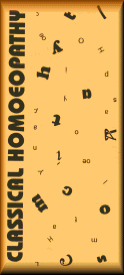|
Conventional medicine conditions us to believe that the symptoms of
cerebrovascular accident (CVA ), better known as "stroke"
are alike or common in all people. Paralysis, weakness and defective
or absent speech (aphasia ) are examples. Homeopathy, however, makes
us understand that the symptom picture in any disease is unique to the
individual and must be observed very carefully.
As devastating and frightening as a stroke may be, from a
homeopathic perspective the symptoms actually represent the attempt of
a person's "vital force," or guiding energy, to correct the
imbalance which has resulted in the state. Observing and following the
individual symptom picture will lead the homeopath to prescribe the
remedy most "similar" to the CVA. The patient should then be
on the way to recovery from the energetic imbalance in a shorter time
than if treated by conventional methods only.
Two Stroke Remedies
There are many remedies that can be used to address stroke, each
portraying a particular mental, emotional and physical profile.
For example, let's look at the "portrait" of the remedy
know as Gelsemium ( Yellow Jasmin ). I like to think of Gelsemium
as the "D" remedy -- drowsy, dull, dusky, dizzy, dumb,
droopy and dopey. Gelsemium acts on the nerves and motor
nerves. In it we see paralysis of groups of muscles and a lack of
motor co-ordination.
In cases of stroke we see a general relaxed state of the system with
weakness and trembling. The muscles seem to refuse to obey the will.
Almost complete generalized paralysis, intense passive congestion to
the head, headaches accompanied by nausea, dizziness and staggering
are present. In the Gelsemium stroke the brain feels tight and
the limbs carry it's characteristic heaviness, fatigue and trembling.
The face may be heavy, flushed and besotted. The speech is thick,
making the patient sound as if he or she is intoxicated. The Gelsemium
patient may be incoherent and seem stupid and forgetful.
In contrast, indications of a remedy called Cocculus (
Indian Cockle ) include more of an emphasis on vertigo and nausea. The
stroke may be preceded by these two symptoms as well as by convulsive
movement of the eyes and paralysis, especially of the lower limbs. In
the Cocculus stroke, the patient will experience a violent
headache that runs from the vertex to the left side of the forehead
and nose, and/or a feeling of opening and shutting in the back of the
head and nape of the neck.
There is a general uncoordination and numbness and the
characteristic symptoms of whirling virtigo, and nausea with the
inclination to vomit will be present. As a result of the later, there
is a refusal to eat, as the thought or smell of food increases the
nausea.
When given to the patient, the homeopathic remedy acts as an "artificial"
or " like" illness that stimulates or jump-starts the vital
force to react against the imbalance. Once the imbalance is corrected,
the symptoms are no longer necessary and the disease state dissipates.
The above, of course, is an oversimplification of homeopathic case
taking, which is highly intricate and requires a skilled homeopath.
Those dealing with any acute or chronic condition should consult a
qualified practitioner.
Barbara Etcovitch is a classical homeopath practising in Ottawa,
Toronto and Montreal
This article first appeared in "Alive" magazine May
1998
Return to Home
Page |
